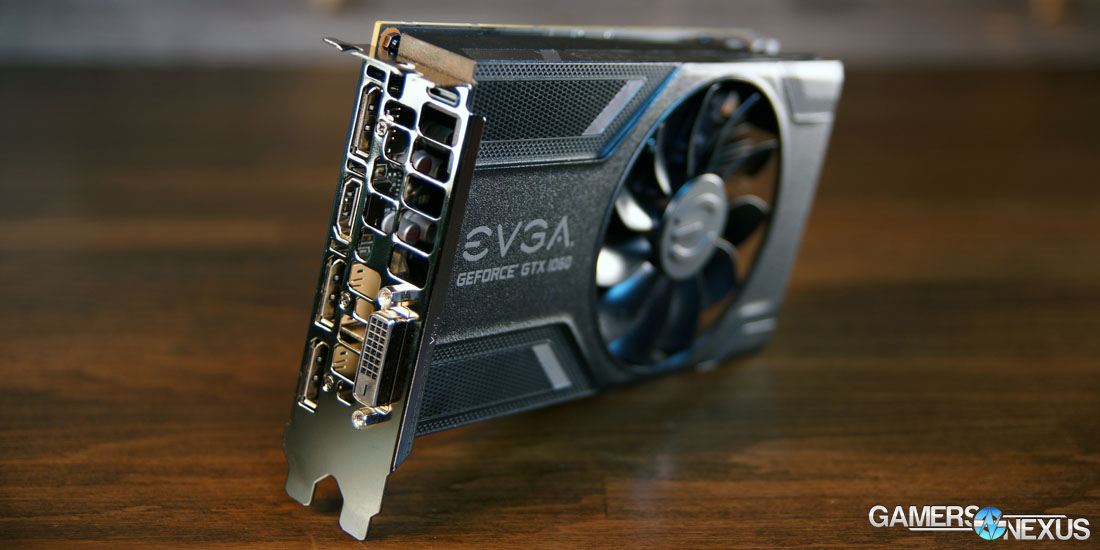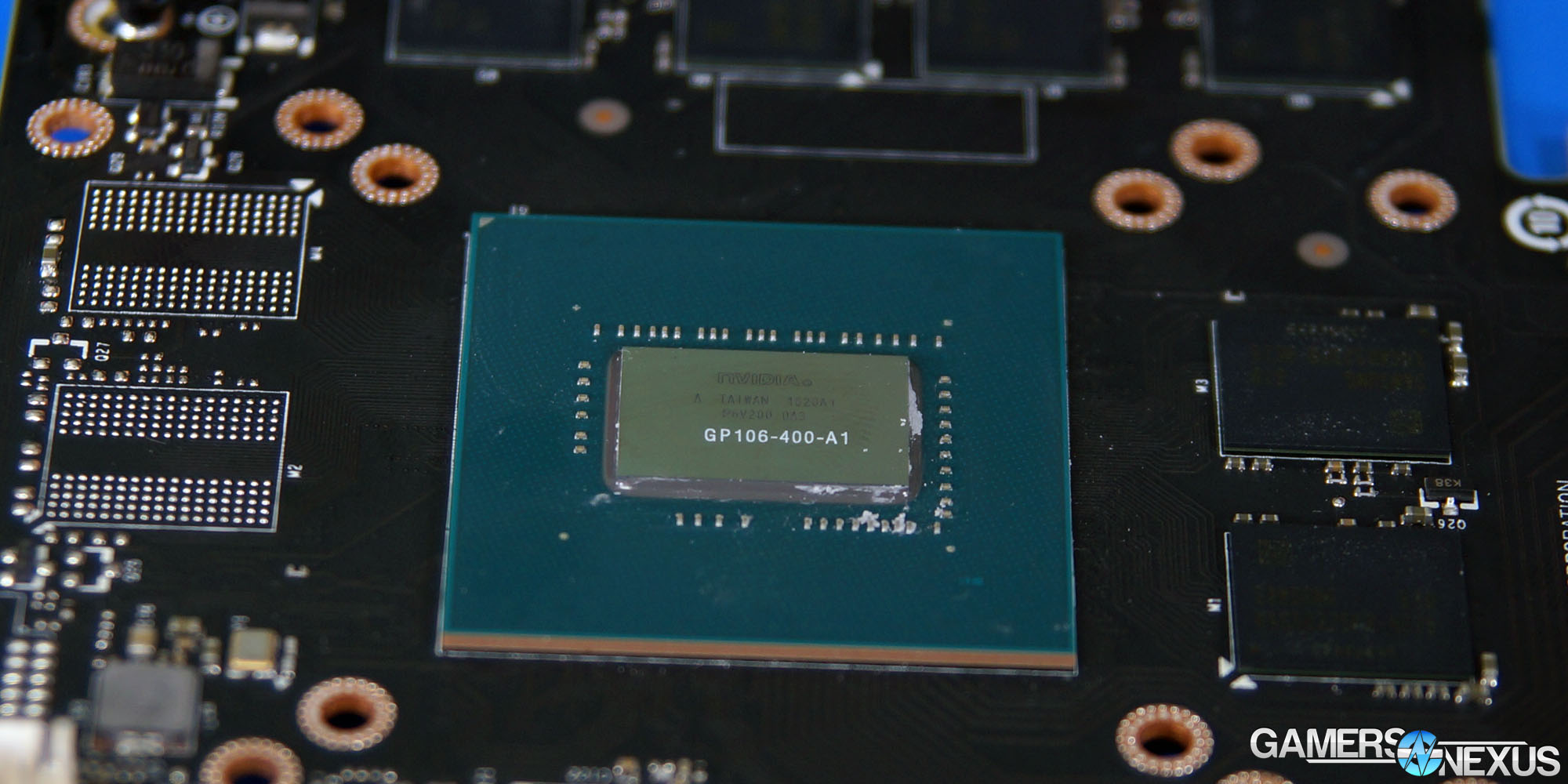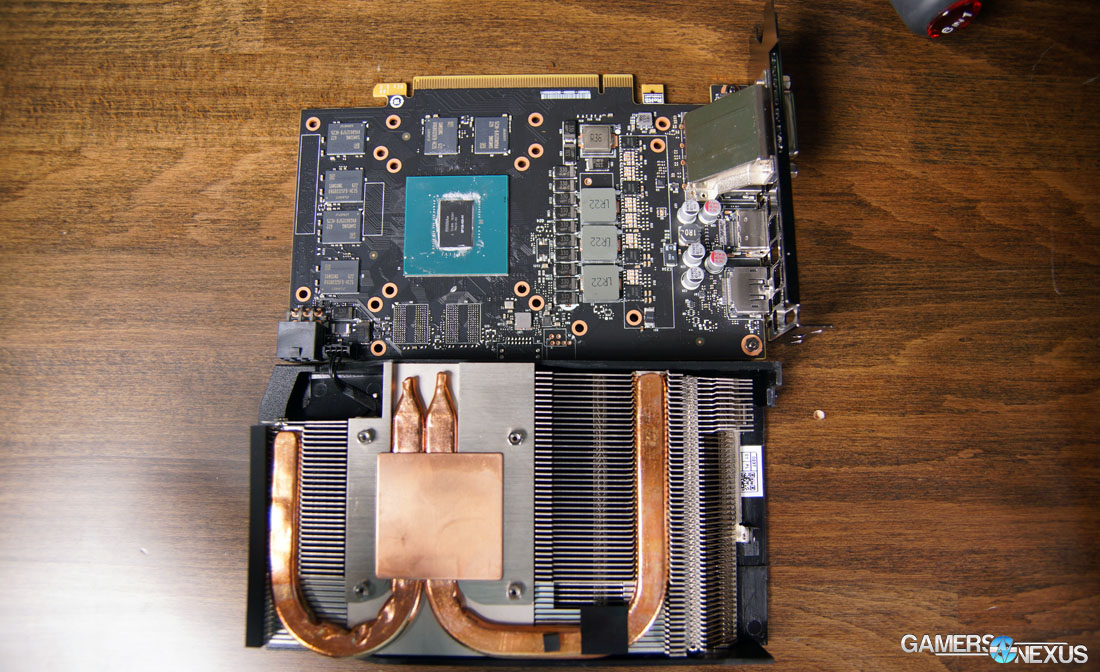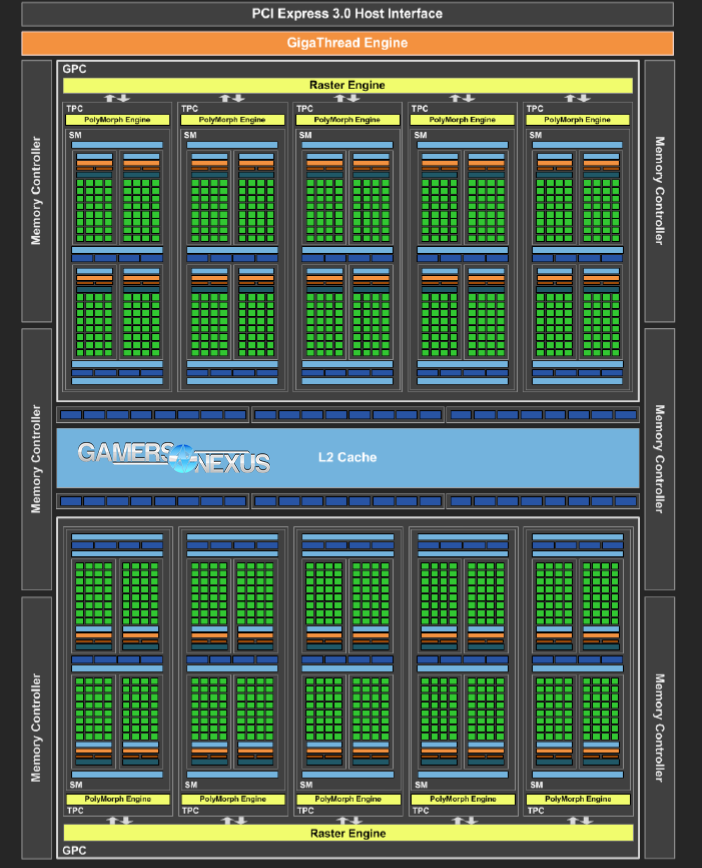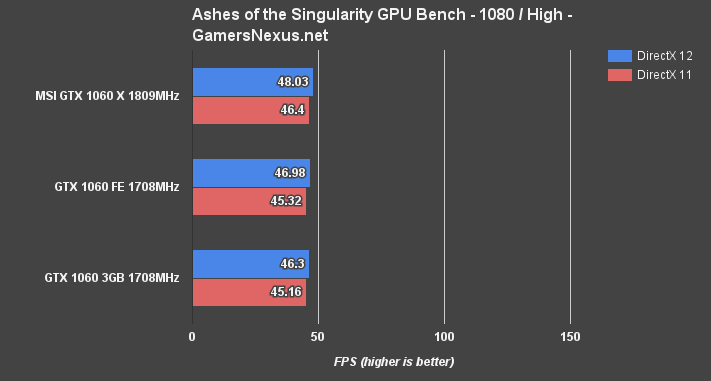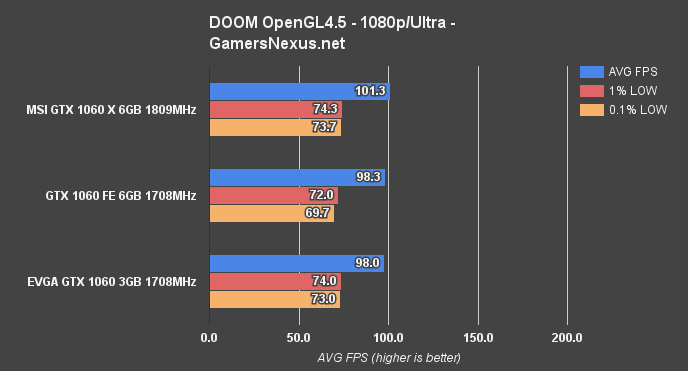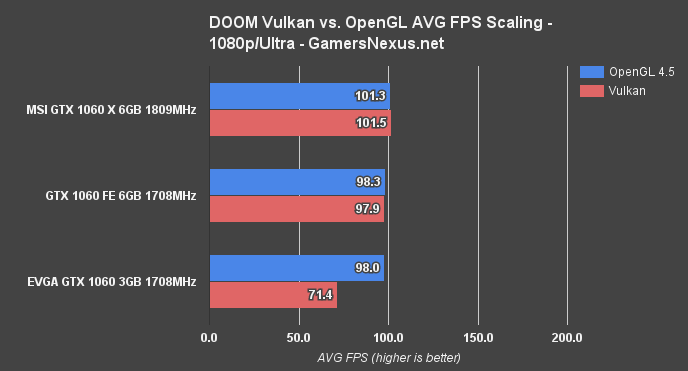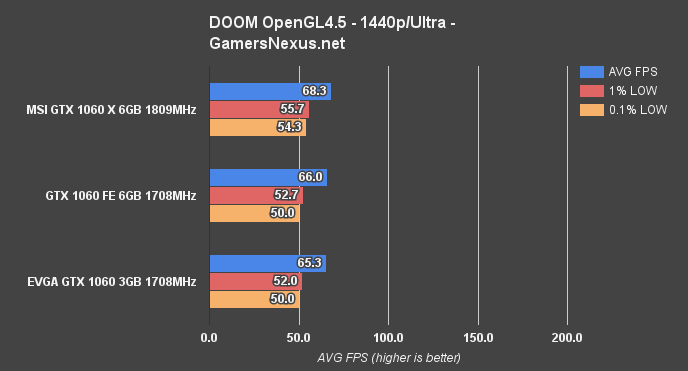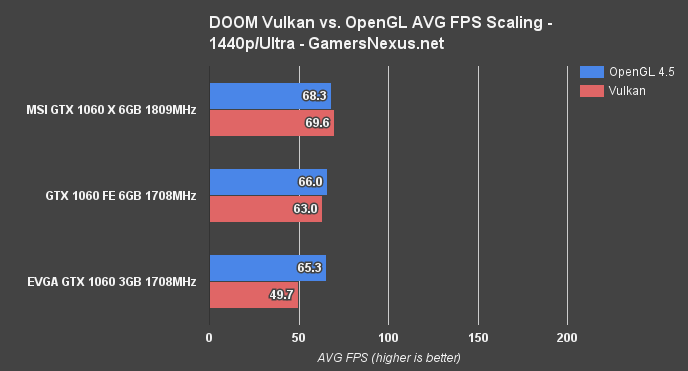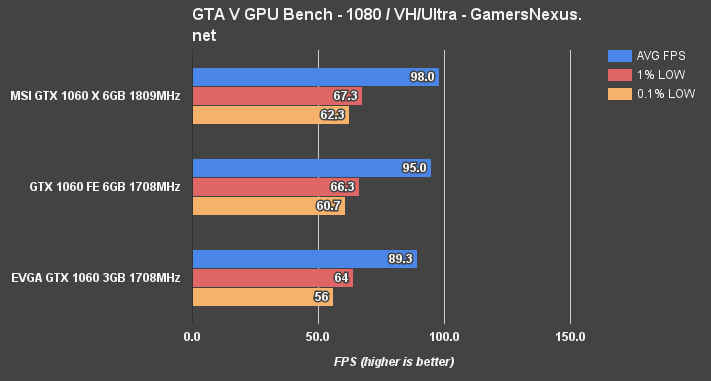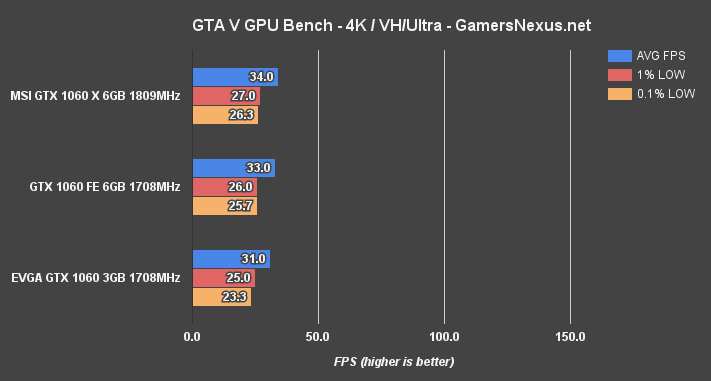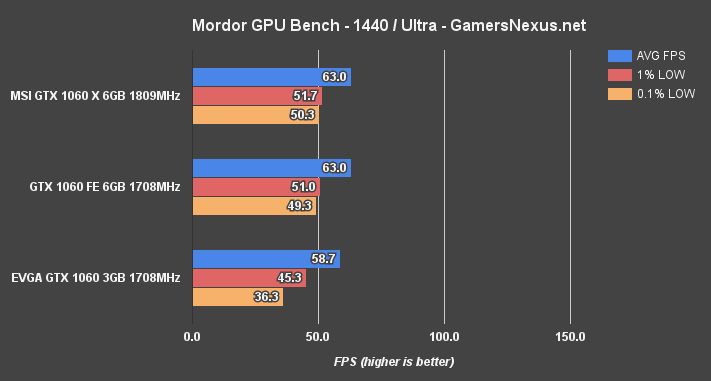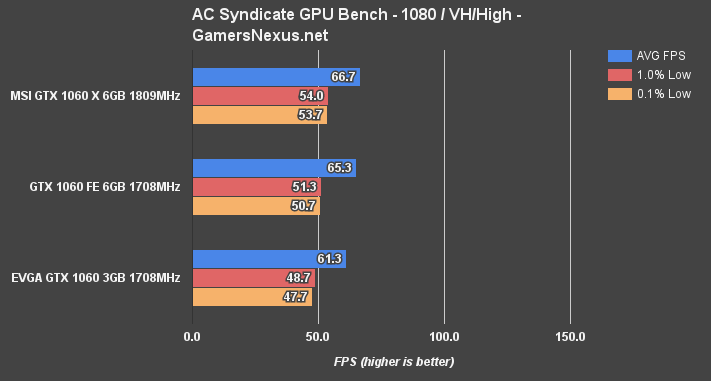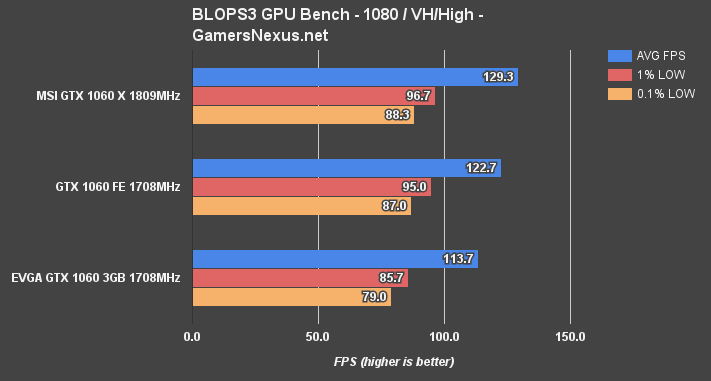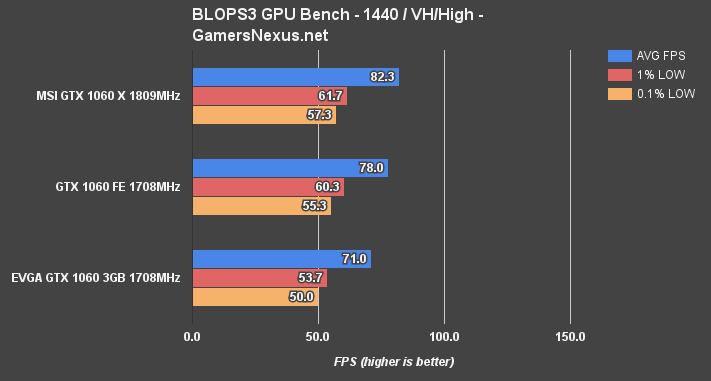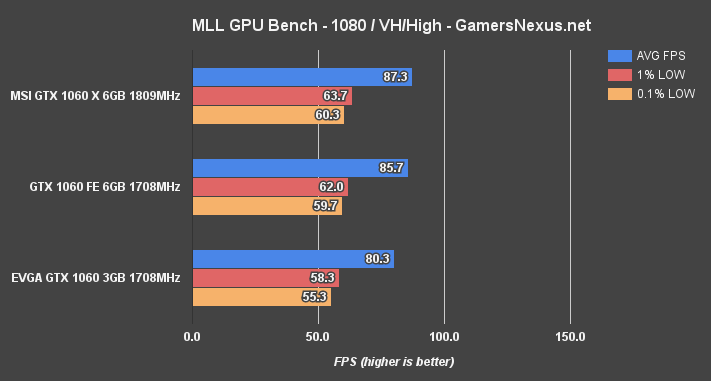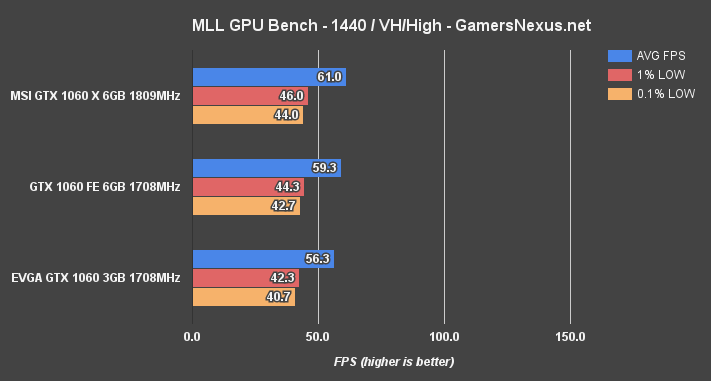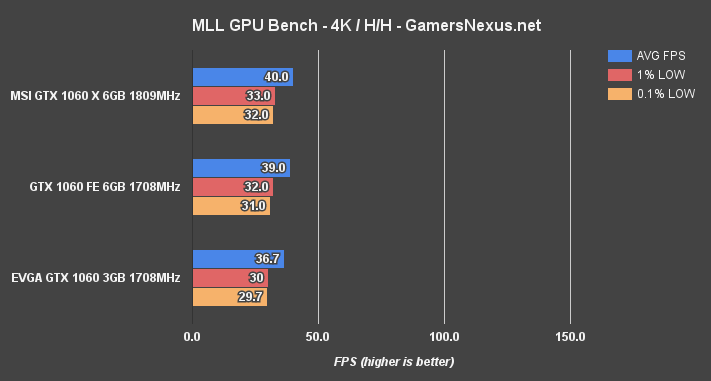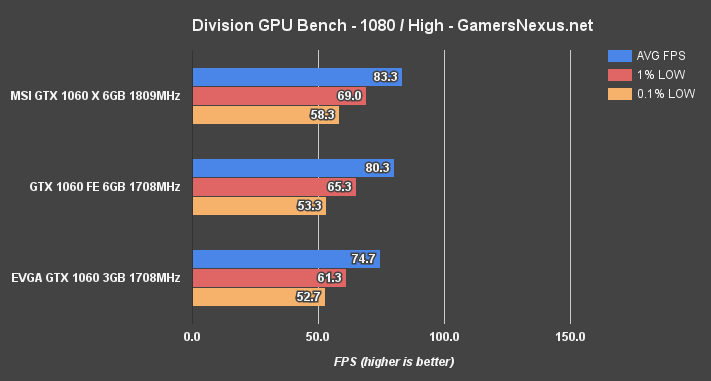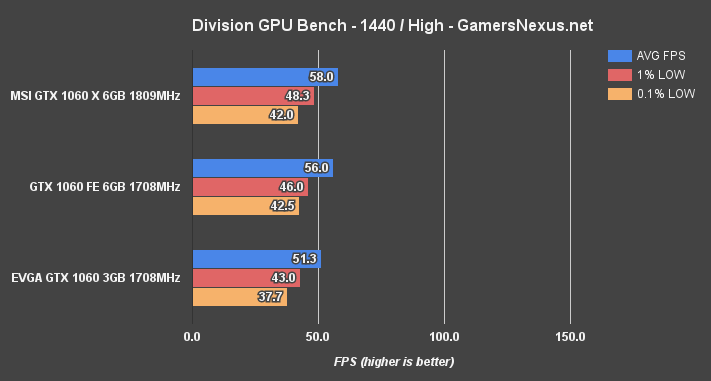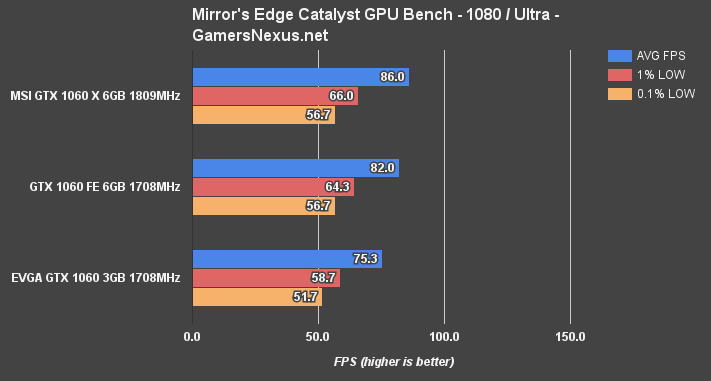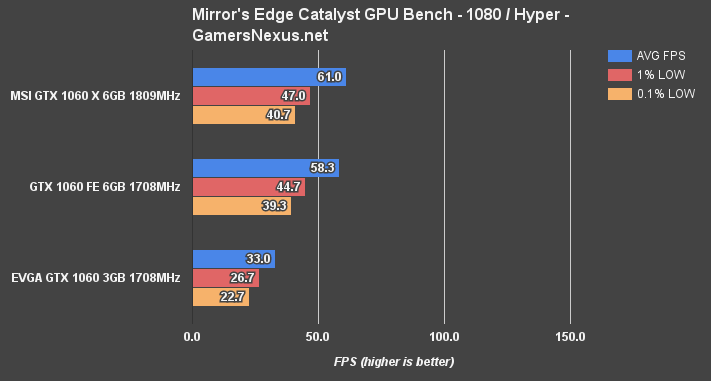The GTX 1060 3GB ($200) card's existence is curious. The card was initially rumored to exist prior to the 1060 6GB's official announcement, and was quickly debunked as mythological. Exactly one month later, nVidia did announce a 3GB GTX 1060 variant – but with one fewer SM, reducing the core count by 10%. That drops the GTX 1060 from 1280 CUDA cores to 1152 CUDA cores (128 cores per SM), alongside 8 fewer TMUs. Of course, there's also the memory reduction from 6GB to 3GB.
The rest of the specs, however, remain the same. The clock-rate has the same baseline 1708MHz boost target, the memory speed remains 8Gbps effective, and the GPU itself is still a declared GP106-400 chip (rev A1, for our sample). That makes this most the way toward a GTX 1060 as initially announced, aside from the disabled SM and halved VRAM. Still, nVidia's marketing language declared a 5% performance loss from the 6GB card (despite a 10% reduction in cores), and so we decided to put those claims to the test.
In this benchmark, we'll be reviewing the EVGA GTX 1060 3GB vs. GTX 1060 6GB performance in a clock-for-clock test, with 100% of the focus on FPS. The goal here is not to look at the potential for marginally changed thermals (which hinges more on AIB cooler than anything) or potentially decreased power, but to instead look strictly at the impact on FPS from the GTX 1060 3GB card's changes. In this regard, we're very much answering the “is a 1060 6GB worth it?” question, just in a less SEF fashion. The GTX 1060s will be clocked the same, within normal GPU Boost 3.0 variance, and will only be differentiated in the SM & VRAM count.
For those curious, we previously took this magnifying glass to the RX 480 8GB & 4GB cards, where we pitted the two against one another in a versus. In that scenario, AMD also reduced the memory clock of the 4GB models, but the rest remained the same.
Today will remain focused strictly on GTX 1060 cards. That means the charts will not have the dozen other cards we've tested on them, for sake of ease and a focused test. If you want to know the results of an RX 480 vs. GTX 1060, or of all the other cards out this generation, check here:
RX 480 Review (prior to 1060 launch)
GTX 1080 Hybrid vs. Sea Hawk review (high-end cards)
GTX 1060 3GB vs. 6GB Specs Differences
| NVIDIA Pascal vs. Maxwell Specs Comparison | |||||
| GTX 1080 | GTX 1070 | GTX 1060 3GB | GTX 1060 6GB | GTX 960 | |
| GPU | GP104-400 Pascal | GP104-200 Pascal | GP106 Pascal | GP106 Pascal | GM204 |
| Transistor Count | 7.2B | 7.2B | 4.4B | 4.4B | 2.94B |
| Fab Process | 16nm FinFET | 16nm FinFET | 16nm FinFET | 16nm FinFET | 28nm |
| CUDA Cores | 2560 | 1920 | 1152 | 1280 | 1024 |
| GPCs | 4 | 3 | 2 | 2 | 2 |
| SMs | 20 | 15 | 9 | 10 | 8 |
| TPCs | 20 | 15 | 9 | 10 | - |
| TMUs | 160 | 120 | 72 | 80 | 64 |
| ROPs | 64 | 64 | 48 (?) | 48 | 32 |
| Core Clock | 1607MHz | 1506MHz | 1506MHz | 1506MHz | 1126MHz |
| Boost Clock | 1733MHz | 1683MHz | 1708MHz | 1708MHz | 1178MHz |
| FP32 TFLOPs | 9TFLOPs | 6.5TFLOPs | 3.85TFLOPs | 3.85TFLOPs | 2.4TFLOPs |
| Memory Type | GDDR5X | GDDR5 | GDDR5 | GDDR5 | GDDR5 |
| Memory Capacity | 8GB | 8GB | 3GB | 6GB | 2GB, 4GB |
| Memory Clock | 10Gbps GDDR5X | 4006MHz | 8Gbps | 8Gbps | 7Gbps |
| Memory Interface | 256-bit | 256-bit | 192-bit | 192-bit | 128-bit |
| Memory Bandwidth | 320.32GB/s | 256GB/s | 192GB/s | 192GB/s | 115GB/s |
| TDP | 180W | 150W | 120W | 120W | 120W |
| Power Connectors | 1x 8-pin | 1x 8-pin | 1x 6-pin | 1x 6-pin | 1x 6-pin |
| Release Date | 5/27/2016 | 6/10/2016 | August, 2016 | 7/19/2016 | 01/22/15 |
| Release Price | Reference: $700 MSRP: $600 | Reference: $450 MSRP: $380 | MSRP: $200 | Reference: $300 MSRP: $250 | $200 |
Before getting to the heart of the content, just a quick note to clear things up: We've seen some comments asking why this isn't a “4GB card instead of a 3GB card.” It's not possible. At least, not with this current 1060 setup, and not in a way that makes sense.
Because of the way the GTX 1060 builds its memory subsystem, including use of a 192-bit interface, it is not possible to run a 4GB solution. Generally, when you see a multiple of 3 – like a 6GB card – that card will only ship in other multiples of 3, like a 3GB card. The same is true for 4GB and 8GB units – you'll never see a 4GB card with a 3GB alternative; it will always be 4GB or 2GB, or 4GB or 8GB, and so forth.
It's not quite so easy to put memory modules of new capacities or with a different channel count onto a board, then tell a GPU (which is built for another memory spec) to work with that setup. This wasn't a case of “nVidia had an option to do 4GB, but did 3GB for cost,” it was a case of not being possible to do a 4GB setup on the GP106-400 GPU architecture.
Comparing the Silicon
Above: The GTX 1060 FE GPU
Above: The small 3GB card torn-down. Same GPU.
Above are two photos of the torn-down cards under test: The GTX 1060 6GB FE and the EVGA GTX 1060 3GB. The GPU, plainly, is the same. GP106-400-A1 for each. Here's a block diagram of the GP106-400 GPU:
Imagine this with one less SM, and you've got the GTX 1060 3GB.
Continue to the next page for testing methodology.
Game Test Methodology
We tested using our GPU test bench, detailed in the table below. Our thanks to supporting hardware vendors for supplying some of the test components.
AMD 16.8.1 drivers were used for the RX 470 & 460 graphics cards. 16.7.2 were used for testing GTA V & DOOM (incl. Vulkan patch) on the RX 480. Drivers 16.6.2 were used for all other devices or games. NVidia's 372.54 drivers were used for game (FPS) testing on the GTX 1080 and 1060. The 368.69 drivers were used for other devices. Game settings were manually controlled for the DUT. All games were run at presets defined in their respective charts. We disable brand-supported technologies in games, like The Witcher 3's HairWorks and HBAO. All other game settings are defined in respective game benchmarks, which we publish separately from GPU reviews. Our test courses, in the event manual testing is executed, are also uploaded within that content. This allows others to replicate our results by studying our bench courses. In AMD Radeon Settings, we disable all AMD "optimization" of graphics settings, e.g. filtration, tessellation, and AA techniques. This is to ensure that games are compared as "apples to apples" graphics output. We leave the application in control of its graphics, rather than the IHV. In NVIDIA's control panel, we disable G-Sync for testing (and disable FreeSync for AMD).
Windows 10-64 build 10586 was used for testing.
Each game was tested for 30 seconds in an identical scenario, then repeated three times for parity.
Average FPS, 1% low, and 0.1% low times are measured. We do not measure maximum or minimum FPS results as we consider these numbers to be pure outliers. Instead, we take an average of the lowest 1% of results (1% low) to show real-world, noticeable dips; we then take an average of the lowest 0.1% of results for severe spikes.
| GN Test Bench 2015 | Name | Courtesy Of | Cost |
| Video Card | This is what we're testing! | - | - |
| CPU | Intel i7-5930K CPU | iBUYPOWER | $580 |
| Memory | Corsair Dominator 32GB 3200MHz | Corsair | $210 |
| Motherboard | EVGA X99 Classified | GamersNexus | $365 |
| Power Supply | NZXT 1200W HALE90 V2 | NZXT | $300 |
| SSD | HyperX Savage SSD | Kingston Tech. | $130 |
| Case | Top Deck Tech Station | GamersNexus | $250 |
| CPU Cooler | NZXT Kraken X41 CLC | NZXT | $110 |
For Dx12 and Vulkan API testing, we use built-in benchmark tools and rely upon log generation for our metrics. That data is reported at the engine level.
Video Cards Tested
- Corsair Hydro GFX GTX 1080 ($750)
- Sapphire RX 470 Platinum (~$180?)
- MSI RX 480 Gaming X
- MSI GTX 1060 Gaming X ($290)
- NVIDIA GTX 1060 FE ($300)
- AMD RX 480 8GB ($240)
- NVIDIA GTX 1080 Founders Edition ($700)
- NVIDIA GTX 980 Ti Reference ($650)
- NVIDIA GTX 980 Reference ($460)
- NVIDIA GTX 980 2x SLI Reference ($920)
- AMD R9 Fury X 4GB HBM ($630)
- AMD MSI R9 390X 8GB ($460)
- And more
Continue to Page 3 for the Dx12 & Vulkan / OpenGL tests, or Page 4 for DirectX 11.
Ashes of the Singularity (Dx12) Benchmark – GTX 1060 3GB vs. 6GB
Ashes of the Singularity shows no real performance difference between the GTX 1060 cards, including the MSI GTX 1060 Gaming X and its pre-overclock. On the whole, we're seeing identical performance. Tests have to be run multiple times to average results out, despite the 3-minute run-time, when dealing with cards that are this close in performance. After the tests, we end up with a 46.3FPS AVG for Dx12 on the GTX 1060 3GB card (from EVGA, clocked stock at 1708MHz boost), 45.16FPS AVG for Dx11, and framerates under 1FPS higher with the GTX 1060 FE 6GB card.
The clock-rate has a more noticeable impact, carrying the MSI GTX 1060 Gaming X (at 1809MHz advertised boost) up to 48.03FPS AVG with DirectX 12, or 46.4FPS AVG for DirectX 11 performance.
Here's the chart:
DOOM (Vulkan & OpenGL) Benchmark – GTX 1060 3GB vs. 6GB
OpenGL results with DOOM are largely the same between the GTX 1060 3GB and GTX 1060 6GB cards. 1080p results are just under 100FPS AVG, and the lows are fairly tightly timed for each. Vulkan testing does produce some screwy results, though: The 6GB card vastly outperforms the 3GB card with Vulkan enabled, posting a 1080p performance difference of 26.5FPS – or 37%. At 1440p, we see similarly tied OpenGL performance – both cards operating around 65FPS – which is then tanked for the 3GB card with Vulkan. Vulkan positions the GTX 1060 3GB card at 50FPS, with the 6GB FE card at 63FPS. That's a difference of 13FPS, or 27%.
This difference only seems to exist with Vulkan for DOOM, and because the cards still perform better with OpenGL, you'd be best off taking that setup.
GTA V Benchmark – GTX 1060 3GB vs. 6GB
Starting with GTA V at 1080p and Very High / Ultra settings, the GTX 1060 6GB card performs at 95FPS AVG with 66.3FPS and 60.7FPS lows. The GTX 1060 3GB trails this at 89.3FPS AVG, 64FPS 1% low, and 56FPS 0.1% lows. At this resolution, the differences are largely inconsequential to gameplay, but are measurable. The performance difference is about 6.3% between the two, with the MSI GTX 1060 Gaming X ($280) marginally ahead of each of these, a result of its higher clock-rate.
At 1440p, we're looking at 68FPS AVG for the 6GB card, or about 63FPS average for the 3GB card. The 0.1% lows are mostly the same between the two, and that remains the case for 4K – which is too taxing for the 1060, anyway, but a worthwhile benchmark to see if any hidden failures are rooted-out.
Shadow of Mordor Benchmark – GTX 1060 6GB vs. 3GB FPS
Shadow of Mordor produces more varied results. At 1080p, the GTX 1060 6GB card operates at 87.7FPS AVG, with lows ranked at 68.7FPS and 66FPS 0.1% low. The 3GB card runs at 77.3FPS AVG – a percent change of 13.5%, old to new – with the lows most noticeably different at 45FPS versus 66FPS on the 6GB card. That's the big point, here, and generally has been for VRAM differences in these tests.
Moving to 1440p, the trend continues and posts the GTX 1060 6GB at 63FPS AVG, 51FPS 1% low, and 49.3FPS 0.1% low. The 3GB card sustains 58.7FPS AVG, 45.3FPS 1% low, and 36.3FPS 0.1% lows – a somewhat significant difference, and one which is edging on visible, though it depends on what's going on in-game.
Assassin's Creed: Syndicate – GTX 1060 6GB vs. 3GB
Assassin's Creed Syndicate was revived because it has historically shown us fairly large performance gaps between 4GB and 8GB solutions – like the RX 480 4GB, which struggled in its lows when compared to the RX 480 8GB. In this benchmark, though, we're seeing similar performance from each card. The 1060 6GB card is slightly ahead, but there's no game-breaking disparity. Stutters are infrequent on both devices, and lows are mostly identical.
Call of Duty: Black Ops III Benchmark – GTX 1060 3GB or 6GB
Call of Duty: Black Ops III is a title fairly sensitive to clock-rate and VRAM changes, and we can normally rely on it to show swings between similar spec cards. At 1080p, the GTX 1060 6GB card is performing at 122.7FPS AVG, with the 3GB card at 113.7FPS AVG. That's a performance change of about 8%. The 1% low values are gapped by 10FPS, with the 0.1% lows similarly spaced at 87FPS and 79FPS. This maintains a performance difference in the low metrics of about 8 to 10%.
1440p posts slightly bigger scaling gaps, with the 6GB card at 78FPS AVG and the 3GB card at 71FPS AVG. That's a 10% performance difference, or twice the 5% advertised by nVidia. 1% lows are also fairly gapped, at 60.3FPS and 53.7FPS.
Metro: Last Light Benchmark – GTX 1060 3GB vs. 6GB
Metro: Last Light shows fairly linear scaling across the board, with the 3GB card not visually worse than the 6GB model.
The Division – GTX 1060 3GB vs. 6GB FPS Benchmark
The Division shows a measurable gap at 74.7FPS AVG for the 3GB card, or 80.3FPS for the 6GB card, but not one which is inherently visible to gameplay. The same remains true when dropping to 1440p, with both cards within a few FPS of one another – though the 0.1% lows do start seeing some threat on the 3GB card, they are still within a range of “measurable, but not perceptible.”
Mirror's Edge Catalyst (Hyper & Ultra) – GTX 1060 6GB vs. 3GB
Mirror's Edge Catalyst posts some of the biggest performance differences for these cards, as we've previously found with the RX 480 4GB vs. 8GB cards.
At 1080p/ultra, the difference is present, but not dismal – we're at 82FPS AVG for the GTX 1060 FE 6GB, and 75.3FPS AVG for the 3GB alternative. That's a reasonable gap – more than the 5% nVidia advertises – but not terrible.
What is a terribly large gap, though, is the Hyper performance. We're seeing a dip from 58.3FPS AVG and 39.3FPS 0.1% low, numbers which are generally considered “playable” for MEC, down to 33FPS AVG and 22.7FPS 0.1% low. Just over half the performance with the 3GB card, thanks to MEC's VRAM-intensive Hyper setting. Sure, the settings could be dropped to Ultra – but with a GTX 1060 6GB capable of playing Hyper just fine, for the most part, this is a big change. Our tests make clear that the 3GB model of the GTX 1060 is not, in fact, an effective equivalent to the 6GB model.
Continue to the final page for the conclusion.
Is the GTX 1060 6GB Worth It?
This comes down to a question of whether the difference is ever noticeable in gameplay, and if it's worth the $50 extra for the 6GB card. We know that overclocking would scale performance mostly linearly, especially shown by testing the cards clock-for-clock, and that the performance deltas can be mapped to the reduction in CUDA cores and VRAM. For most games, the difference is about 6 to 7%, but we're seeing huge swings in some cases. Black Ops III posts a 10% performance change going from the 6GB card to the 3GB card ($200), Shadow of Mordor shows about a 14% change, and Doom is nearly 0 with OpenGL, but posts massive, 27% differences with Vulkan.
And then there's Mirror's Edge Catalyst, where we saw a performance drop from 58.3FPS AVG / 39.3FPS 0.1% low with the 6GB card, the 3GB model falling at 33FPS AVG / 22.7FPS 0.1% low. That pushes us below the “playable” threshold for Mirror's Edge Catalyst at Hyper, which wasn't the case for the 1060 6GB unit. A purchaser of the 3GB card would have to drop settings to Ultra (1080p) to remain playable on the unit, whereas the 6GB owner could play at Hyper.
The 3GB GTX 1060 is OK in some select cases. When the GTX 1060 3GB's frames dip, they dip hard. That can be the difference of adding noticeable chop to 1440p gameplay with the wrong settings combination, and is particularly noticeable with VRAM intensive applications. MEC requires a settings reduction, as the major example, and Shadow of Mordor is edging on one. But outside of these poor performances, the 3GB card does reasonably well in most other aspects of gaming. It's not the 5% difference that nVidia advertised, but the difference is often between 6% and 7%, so this isn't some world-ending offense.
Going forward, we'd still recommend the 6GB GTX 1060 for most use cases – it's one of the only cards this generation to be available at MSRP, near $250, and that makes it an agreeable purchase. This is a similar situation to the 4GB RX 480, which we generally would forgo for the 8GB model; that said, we did see some larger swings in 4 vs. 8GB RX 480 performance.
Just as a reminder, here are two of the opposing charts re-printed (arguing similar performance and arguing disparate performance, for an even match):
Naming Choices
As for the naming, that's another matter. This isn't a lower VRAM GTX 1060 – it's a different card. An entire SM is disabled, including one tenth of the card's processors, and it's half the VRAM. The GTX 1060 3GB should absolutely not be called a GTX 1060. For consumers who are already faced with seemingly endless variants of AIB partner cards – Xs and Zs and Gamings and SCs or SSCs or FTWs or Strix, and on, and on – this only further obfuscates the GTX 1060 pool. It's just not a GTX 1060 – it's a different product. NVidia's choice to name the card as such will confuse buyers into thinking it's just a 1060 with half the VRAM, which is plainly false. This is a GTX 1050 Ti, and nVidia decided not to call it that. It's a marketing play. That doesn't necessarily mean it's a bad thing – all these companies make marketing plays (see: 4GB RX 480 for “$200 VR” ads) – but this isn't one that we can brush aside as harmless, because users will inevitably make the incorrect assumption that the only difference is VRAM.
As for being VR-ready, you're losing a lot of performance just with normal gaming. Don't buy this for VR. You'll want more than 3GB VRAM for that, anyway, and the performance loss is painful when dealing with the extremely tight tolerances of VR.
The 3GB GTX 1060 has its place in a few builds with an odd budget distribution, and does deserve to exist – we just think it should be renamed and mostly ignored in favor of the $250 alternatives, including the 6GB 1060 and 8GB RX 480.
Editorial, Test Lead: Steve “Lelldorianx” Burke
Video Producer: Andrew “ColossalCake” Coleman
Test Technician: Andie “Draguelian” Burke
